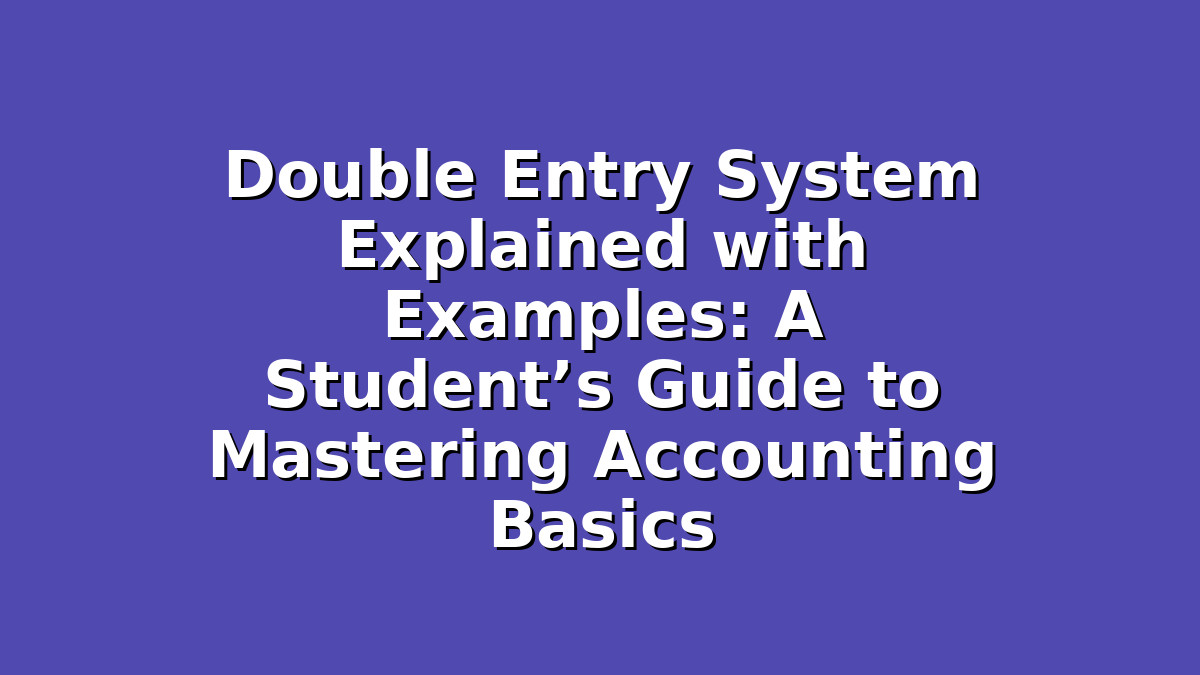If you’re preparing for exams or simply trying to strengthen your understanding of accounting fundamentals, the double entry system is a concept you must master. This system forms the backbone of modern accounting, ensuring accuracy and clarity in financial records. But what exactly is the double entry system, and how can you best learn it? In this article, we’ll break down the concept with clear explanations and practical examples, along with study tips tailored for students like you. By the end, you’ll be more confident tackling accounting questions and managing your study sessions effectively.
What is the Double Entry System?
At its core, the double entry system is a method of bookkeeping where every financial transaction affects at least two accounts. This means every debit has a corresponding credit of an equal amount, keeping the accounting equation balanced. The fundamental accounting equation is:
Assets = Liabilities + Owner’s Equity
The double entry system ensures this equation always stays in balance by recording each transaction twice—once as a debit and once as a credit.
For example, if a business buys office supplies for $500 in cash:
– Office Supplies (an asset) increases by $500 — Debit
– Cash (an asset) decreases by $500 — Credit
Both sides offset each other, maintaining balance.
This system helps prevent errors and provides a clear audit trail, which is why it is the standard method used worldwide.
Section 1: Understanding the Basics with Clear Examples
When you’re learning accounting, starting with clear, simple examples helps build a strong foundation. Let’s look at common transactions under the double entry system:
1. Starting a business with cash investment
– Owner invests $10,000 cash into the business.
– Debit: Cash account increases by $10,000.
– Credit: Owner’s Capital account increases by $10,000.
2. Purchasing equipment on credit
– Company buys equipment worth $2,000 on credit.
– Debit: Equipment account increases by $2,000.
– Credit: Accounts Payable increases by $2,000.
3. Providing services and receiving cash
– Business earns $1,500 in service revenue paid immediately.
– Debit: Cash account increases by $1,500.
– Credit: Service Revenue account increases by $1,500.
Each transaction affects two accounts with equal and opposite amounts. To study this effectively:
– Write out each transaction in the T-account format.
– Practice identifying which accounts increase and which decrease.
– Use color coding (e.g., green for debit, red for credit) to visualize flow.
This hands-on approach deepens your understanding and helps you recall concepts during exams.
Section 2: Study Tips for Mastering Double Entry System
Accounting can seem overwhelming, but with the right study strategies, mastering the double entry system is achievable.
1. Break Down Transactions Step-by-Step
When faced with a transaction, dissect it carefully:
– Identify the accounts involved.
– Determine if each account increases or decreases.
– Decide whether to debit or credit each account based on its type (asset, liability, equity, revenue, or expense).
Creating a checklist for this process ensures you don’t miss any steps in your calculations.
2. Use T-Accounts to Visualize Entries
T-accounts are simple tools resembling the letter “T” where debits are written on the left and credits on the right. Drawing T-accounts for each transaction helps you see how debits and credits affect each account.
Make it a routine to:
– Practice setting up T-accounts regularly.
– Record sample transactions.
– Check if the totals balance at the end of each session.
This visual practice reinforces the fundamental rule of double entry bookkeeping.
3. Regular Quizzes and Flashcards
Testing your knowledge frequently helps solidify concepts. Create flashcards with terms like “debit,” “credit,” “accounts payable,” and “owner’s equity,” along with their definitions and examples.
Additionally:
– Solve practice problems related to double entry bookkeeping daily.
– Take online quizzes or use accounting apps designed for students.
– Review your mistakes carefully to avoid repeating them.
Consistent testing improves memory retention and builds your confidence for exams.
Section 3: Applying Double Entry System in Exam Preparation
Exams often require both theoretical knowledge and practical application. Here’s how to prepare effectively:
1. Understand the Theory Behind Double Entry
Don’t just memorize rules; understand why double entry bookkeeping is important:
– Maintains balance in financial records.
– Detects errors early.
– Provides a complete picture of financial health.
This deeper understanding helps you answer conceptual questions convincingly.
2. Practice Journal Entries and Ledger Posting
Be comfortable:
– Writing journal entries for various transactions.
– Posting journal entries to ledger accounts.
– Preparing trial balances to check the accuracy of your work.
Try timed exercises to improve speed and accuracy, which is crucial under exam conditions.
3. Create Summary Sheets
Make a one-page cheat sheet summarizing:
– The types of accounts (assets, liabilities, equity, revenue, expenses).
– Rules for debit and credit for each account type.
– Sample transactions with their entries.
Review this sheet before exams to refresh your memory quickly.
Conclusion
The double entry system is an essential building block of accounting and mastering it will give you a solid foundation for your exams and future studies. By understanding the theory, practicing with clear examples, and applying effective study techniques like T-accounts and regular quizzes, you can confidently take on any accounting problem. Remember, consistency is key—make daily practice a habit and don’t hesitate to ask for help when concepts seem tricky. With patience and effort, you’ll find that double entry bookkeeping becomes second nature.
Keep pushing forward, and good luck on your studies!

Responses